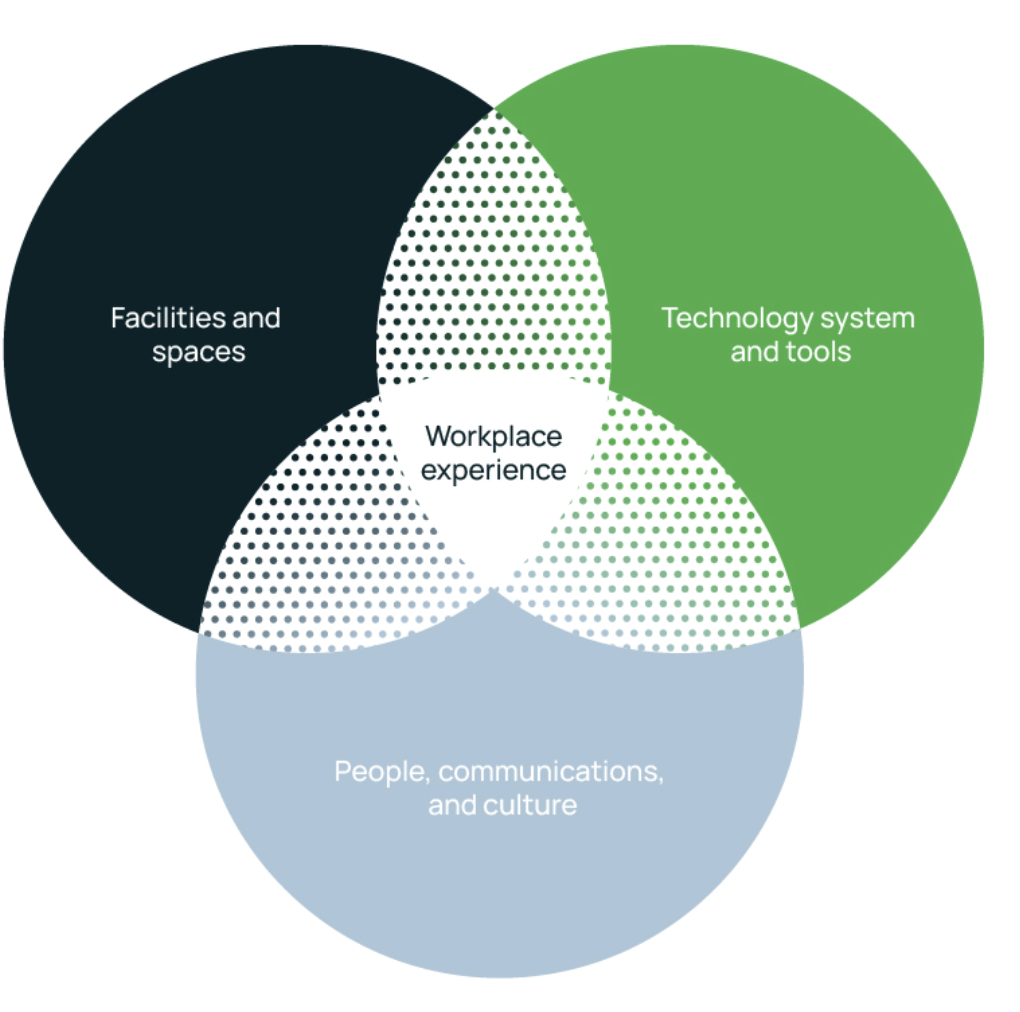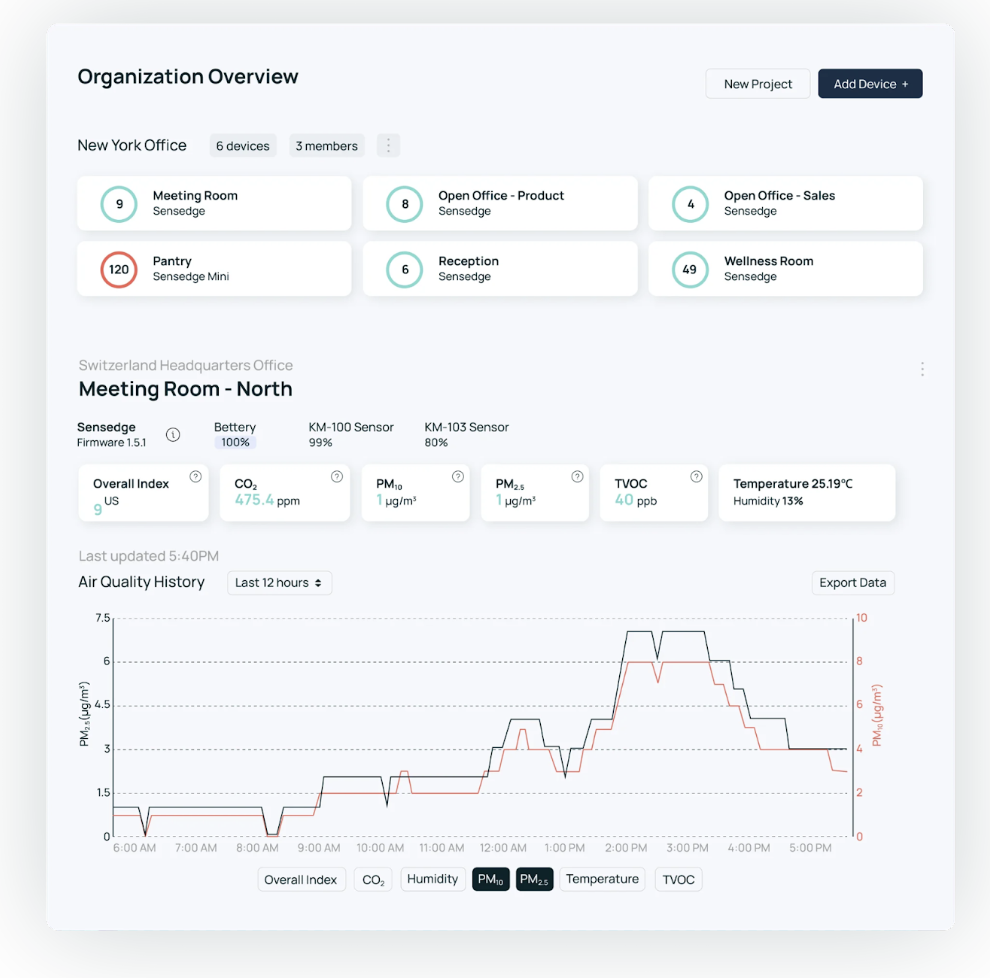Newsletter
What makes a great workplace experience? The answer isn’t more perks or nicer office furnishings. The concept of workplace experience has evolved to encompass everything that influences an employee's perception of their work – from the tools they use to the air they breathe. Organizations are realizing that a positive workplace experience is a driving force that attracts talent, boosts productivity, and fosters loyalty among their employees.
In this guide, we delve into this concept and its most important facets. We'll discuss who is responsible for improving the workplace experience and which metrics are worth analyzing. Specifically, we’ll focus on the role of healthy buildings and indoor air quality in creating a positive and productive work environment.
What is Workplace Experience?
Workplace experience (sometimes abbreviated as WX) refers to the entirety of experiences that an individual has within their place of work. It is a multifaceted concept that involves both the physical and psychological aspects of a person’s work environment. Three broad categories often used in this context are the organizational culture, the technologies and tools provided, and the facilities and space in which work happens.

A holistic view of WX includes the ways in which employees interact with each other and the tools they use to accomplish their tasks. This would cover the impact of technology on work practices, the sense of community within the workplace, and even the ethical values reflected in the organization's modus operandi.
Within the context of WX (and sometimes used interchangeably), workplace wellness is often used to describe initiatives and programs that are designed to bolster the physical, mental, and emotional well-being of employees – with the goal of creating a work environment that actively promotes healthy behaviors, reduces stress, and increases overall job satisfaction.
Why Workplace Experience Matters to Businesses
Today’s employees value the quality of their work life as much as, if not more than, monetary compensation – making workplace experience a key differentiator for employers. This can manifest in multiple operational areas:
Attracting and retaining talent
A positive workplace experience is instrumental in attracting top-tier talent. Millennials and Gen Z workers, who will form 75% of the workforce by 2025, prioritize wellness and shared values over traditional job perks. They are attracted to workplaces that align with their personal principles, such as environmental sustainability and social responsibility, and which offer a positive work atmosphere.
Employee engagement and productivity
The workplace environment plays a decisive role in employee performance. Factors like indoor air quality, noise levels, lighting, and thermal comfort directly have been shown to directly influence both the wellness and the productivity of employees. A well-designed workspace that promotes health and comfort can lead to substantial improvements in individual performance and, consequently, organizational performance.
Employee satisfaction and loyalty
Taking steps to improve the workplace experience can significantly enhance employees' overall job satisfaction. This not only improves their day-to-day sentiment at work, but also increases the overall retention rate, as employees are more likely to remain loyal to a company that values their well-being.
Brand reputation and visibility
Companies prioritizing a healthy and inclusive workplace experience often enjoy a strong, positive reputation in the marketplace. In an increasingly interconnected world, where any employer’s history is just a quick Glassdoor search away, this reputation can help businesses attract and retain prospective talent (and even customers, in some cases).
Who is Responsible for Improving the Workplace Experience?
The responsibility for shaping a positive workplace experience is a joint effort involving multiple operational domains. Traditionally, most of the cultural aspects of WX were handled by human resources (HR) teams, who were tasked with ensuring employee welfare, orchestrating training and growth opportunities, and managing conflict; while considerations related to physical workplace conditions would have fallen under the purview of facility and real estate teams.
However, as the workplace has evolved and demand for better WX has grown, so has the responsibility for workplace experience. Modern companies with big employee counts or office portfolios now have a department in charge of the workplace led by a VP of Workplace / WX. The overall efforts would encompass additional stakeholders, typically including:
- Culture: HR departments, senior executives, and line managers all play a critical role in creating a healthy work climate, giving employees space to maintain work-life balance, and laying the groundwork for a positive workplace culture.
- Facilities and space: Facilities managers, real-estate managers, and architects impact the quality of the physical work environment.
- Technology: With the rise of data-driven approaches to workplace experience, IT and Operations teams are increasingly involved in choosing and implementing tech tools to improve and measure relevant metrics (see below).

Here's a practical example:
Think of an initiative to improve indoor air quality (IAQ) in a workspace—a crucial aspect of staff welfare. Working towards this goal might involve HR initiating the project due to low scores on employee satisfaction surveys. The facilities management team would need to be involved to measure air quality and potentially upgrade air filtration and ventilation systems. They could collaborate with the building operations team to install IAQ monitors and to ensure they're effectively integrated into the existing building management system. Meanwhile, company executives would play a critical role in authorizing the necessary resources and actions for project implementation.
Meaningful Metrics to Understand the Workplace Experience
In the past, discussions about WX would lean towards aspirational (and some would say airy) goals that could not be meaningfully tracked. However, the current tech landscape offers various ways to measure matters that impact overall employee well-being and productivity.
Environmental Metrics
- Indoor air quality: IAQ is a fundamental element of a healthy work environment, affecting both the physical well-being and cognitive performance of employees. We cover this in much more detail below.
- Lighting: Exposure to natural light boosts mood, reduces eye strain, and enhances overall productivity. Metrics here include the amount of natural light available and exposure to blue light levels.
- Noise Levels: This focuses on the levels of exterior and interior noise that might disrupt concentration, impede communication, and increase stress levels.

Non-Environmental Metrics
- Feedback and employee satisfaction surveys: These provide direct input from employees about their experiences and offer valuable insights into areas for improvement. Regularly surveying will give an accurate gauge on the satisfaction level of employees and provide specific pain points to address.
- Use of well-being resources: How often are employees using the resources and initiatives introduced for workplace wellness? The answer to this question can help in measuring the effectiveness and usage of these efforts.
- Digital tool usage: Analysis of how employees use supplied digital tools (like project management platforms, file-sharing systems, etc.) can offer insights into how technology is impacting their workplace experience.
Learn more about adopting a performance-driven approach to workplace experience
Improving the Workplace Experience
As mentioned above, improving the workplace experience is a multifaceted task that involves various aspects of organizational infrastructure – ranging from the physical workspace to digital tools to the company's cultural initiatives. Each organization will be different, and there is no ‘one size fits all’. The specifics depend on the nature of the business, the type of work that’s being done, and existing practices (such as hybrid work policies).
However, there are some key areas that are common to any WX improvement initiative.
Improving facilities and space: Businesses should focus on adopting healthy building principles: Improving indoor air quality and thermal comfort, better management of noise levels, appropriate lighting, and the application of ergonomic considerations to workspaces can all contribute to better facilities.
Technology and systems that drive efficiency: Leveraging and integrating digital technology into the workplace has become a necessity. With the increase in remote and hybrid working models, digital collaboration tools and integrated workplace management systems (IWMS) can facilitate seamless coordination, communication, and efficiency irrespective of the worker's geographical location. Systems that display data from IoT-enabled devices – such as air quality dashboards or occupancy maps – can help create a more transparent picture of a building’s indoor environmental quality.
People and culture: Organizational culture forms the backbone for a positive workplace experience. Transparent communication, upholding a respectful and inclusive culture, prioritizing employees' mental health, and aligning the organization's mission with employees' personal aspirations all contribute to improving the workplace experience.
Read more about 13 ways to improve your workplace experience
Workplace Experience, Healthy Buildings, and Indoor Air Quality
What’s the relationship between workplace experience, healthy buildings, high-performance buildings, and indoor air quality? All of these seemingly disparate concepts are closely tied, and each has an impact on the other. The physical environment where your employees spend most of their waking hours significantly influences their health, productivity, and overall satisfaction; and promoting health and well-being often goes hand-in-hand with productivity gains and a more engaged workforce.
Indoor air quality is a crucial pillar of a healthy building and an optimal workplace experience. Poor IAQ can lead to myriad symptoms, ranging from persistent cold-like symptoms (cough, rashes) to more severe health outcomes and building-related illnesses. At the same time, it hampers cognitive functions and makes it difficult for workers to focus on tasks, think creatively, make decisions, and solve problems – which could also negatively impact productivity and business outcomes.
Measuring key air quality parameters and taking continuous steps to improve them is a crucial stepping stone toward ensuring healthy buildings and a better workspace experience. Implementing continuous IAQ monitoring can help you gather insights about the air your employees are breathing, enabling you to take informed action on how to improve it.
Your ability and willingness to address IAQ issues can act as a clear signal to your employees, clients, and investors about your commitment to their welfare. Being transparent about the indoor environment helps build trust: Sharing real-time air quality data with your employees allows them to understand their work environment better and affirms your commitment to their health and wellbeing.
Improving IAQ is not just a well-being initiative, it's a strategic initiative that helps attract and retain top talent, boost workforce performance, and portray your company as both employee-focused and environmentally responsible. In a labor market that’s still recovering from the effects of the Great Resignation, organizations that prioritize a superior workplace experience will lead the pack.
Start your journey towards better IAQ by exploring Kaiterra's commercial air quality monitors. Because in the quest for a healthier workplace, every breath counts.






.png?width=200&height=148&name=Menu%20C%20(2).png)

.png?width=307&height=228&name=Menu%20-%20D%20(1).png)
.png)



